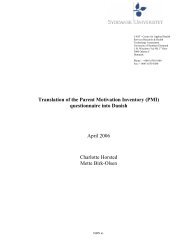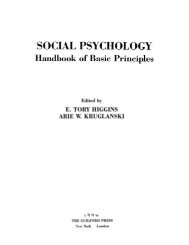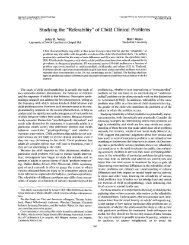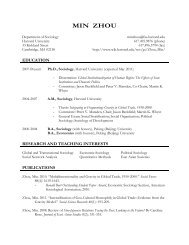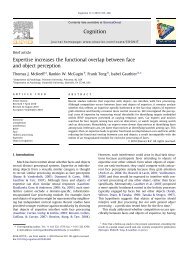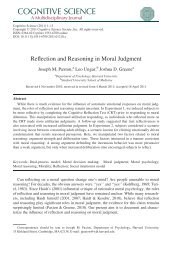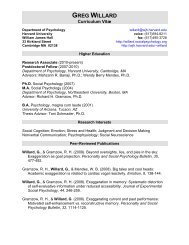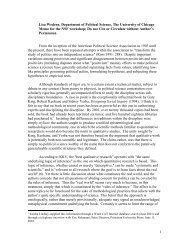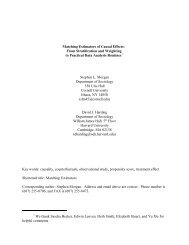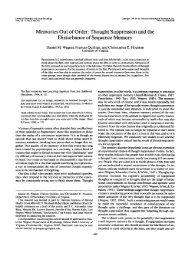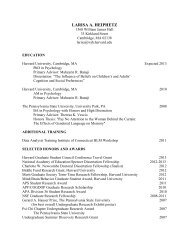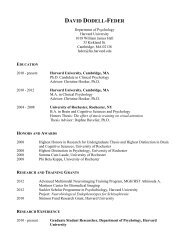A Guide to Writing a Senior Thesis in Sociology - WJH Home Page ...
A Guide to Writing a Senior Thesis in Sociology - WJH Home Page ...
A Guide to Writing a Senior Thesis in Sociology - WJH Home Page ...
You also want an ePaper? Increase the reach of your titles
YUMPU automatically turns print PDFs into web optimized ePapers that Google loves.
You should not th<strong>in</strong>k of your literature review as writ<strong>in</strong>g one paragraph about each<br />
work you read and l<strong>in</strong>k<strong>in</strong>g them <strong>to</strong>gether with a conclud<strong>in</strong>g paragraph. Instead, your<br />
literature review should be organized <strong>in</strong> a way that allows you <strong>to</strong> build <strong>to</strong> a po<strong>in</strong>t and<br />
you should <strong>in</strong>tegrate the evidence you’ve gleaned from several works <strong>to</strong> support this<br />
po<strong>in</strong>t. You should provide a moderate level of detail about each study—e.g., the dataset<br />
or methodology used and the major f<strong>in</strong>d<strong>in</strong>g. But rather than just list<strong>in</strong>g this <strong>in</strong>formation,<br />
you should employ it strategically by compar<strong>in</strong>g or contrast<strong>in</strong>g it with other work<br />
<strong>to</strong> support your ma<strong>in</strong> idea about this body of work.<br />
The culm<strong>in</strong>ation of the literature review should be a discussion of how your thesis<br />
fits <strong>in</strong><strong>to</strong> past research. Are you fill<strong>in</strong>g a hole? Test<strong>in</strong>g or apply<strong>in</strong>g a theory? Expand<strong>in</strong>g<br />
empirical work? At the end of the literature review, it’s often helpful <strong>to</strong> <strong>in</strong>clude a more<br />
developed or detailed version of the research question now that your reader has been<br />
provided with an overview of related research.<br />
Data and Methods<br />
The goal for this section is <strong>to</strong> expla<strong>in</strong> <strong>to</strong> your reader what you did—both how you<br />
collected data and how you analyzed them. You can separate this <strong>in</strong><strong>to</strong> two separate<br />
chapters if you would like. Generally, this section is 10-15 pages.<br />
Data<br />
Walk the reader step-by-step through the process through which you gathered your<br />
data or how the data were collected by an outside agency. Start with the six important<br />
questions: when, where, who, how many, how, and why.<br />
• When: Over what time period were your data collected? Is it from one time period or are there<br />
multiple time periods?<br />
• Where: Is your data from one city? Is it national? Is it from multiple countries?<br />
• Who: Describe the f<strong>in</strong>al analytic sample of subjects (or source materials, <strong>in</strong> the case of content<br />
analysis/his<strong>to</strong>rical projects). What characteristics does the population you studied have? Are you<br />
analyz<strong>in</strong>g a subset of the data? How did you choose this population <strong>to</strong> work with?<br />
• How many: How many cases do you have overall? How many cases are <strong>in</strong> each key subgroup?<br />
What was the response rate?<br />
• How: This encompasses how the data were collected, how the key variables are worded, etc. Did<br />
you collect the data or is it from a secondary source?<br />
o Describe your sampl<strong>in</strong>g method: How did you contact them? If you’re consider<strong>in</strong>g a case<br />
<strong>in</strong>-depth, how did you select your case? If you’re do<strong>in</strong>g content analysis, how did you select<br />
the data you analyzed? If you are not collect<strong>in</strong>g orig<strong>in</strong>al data, how did you select the data-<br />
set you used? Describe the sampl<strong>in</strong>g methods of this dataset—what is the population?<br />
o Describe your <strong>in</strong>strument: What k<strong>in</strong>d of <strong>in</strong>strument did you use? About how long did it take<br />
for each subject <strong>to</strong> complete the data collection process? If you’re do<strong>in</strong>g an ethnography,<br />
how often did you visit the field? How long did you stay <strong>in</strong> the field? What did you do while<br />
you were there? If you are do<strong>in</strong>g content analysis, where did you access the media you<br />
You should not th<strong>in</strong>k of<br />
your literature review as<br />
writ<strong>in</strong>g one paragraph<br />
about each work you<br />
read and l<strong>in</strong>k<strong>in</strong>g them<br />
<strong>to</strong>gether with a conclud<strong>in</strong>g<br />
paragraph. Instead, your<br />
literature review should<br />
be organized <strong>in</strong> a way<br />
that allows you <strong>to</strong> build<br />
<strong>to</strong> a po<strong>in</strong>t and you should<br />
<strong>in</strong>tegrate the evidence<br />
you’ve gleaned from<br />
several works <strong>to</strong> support<br />
this po<strong>in</strong>t.<br />
A <strong>Guide</strong> <strong>to</strong> <strong>Writ<strong>in</strong>g</strong> a <strong>Senior</strong> <strong>Thesis</strong> <strong>in</strong> <strong>Sociology</strong> | page 43




